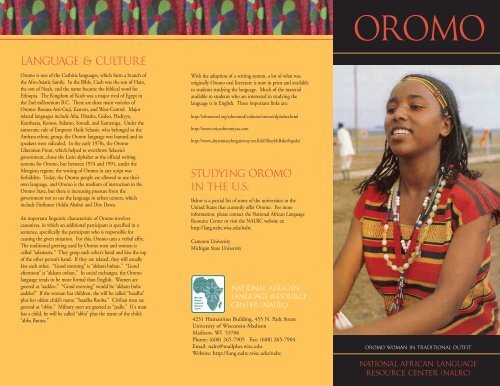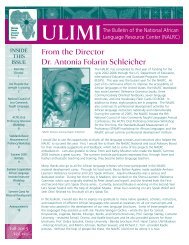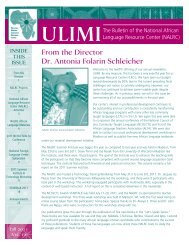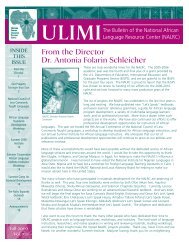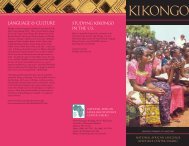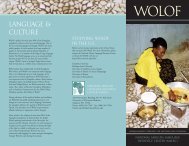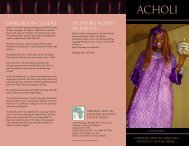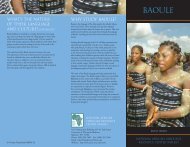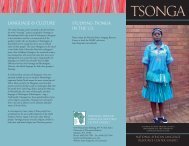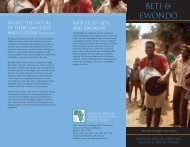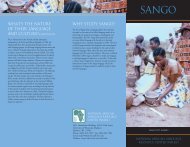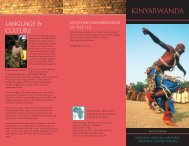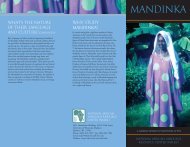Oromo - National African Language Resource Center
Oromo - National African Language Resource Center
Oromo - National African Language Resource Center
- No tags were found...
You also want an ePaper? Increase the reach of your titles
YUMPU automatically turns print PDFs into web optimized ePapers that Google loves.
oromo<strong>Language</strong> & Culture<strong>Oromo</strong> is one of the Cushitic languages, which form a branch ofthe Afro-Asiatic family. In the Bible, Cush was the son of Ham,the son of Noah, and the name became the biblical word forEthiopia. The Kingdom of Kush was a major rival of Egypt inthe 2nd millennium B.C. There are three main varieties of<strong>Oromo</strong>: Borana-Arsi-Guji, Eastern, and West-Central. Majorrelated languages include Afar, Dirasha, Gedeo, Hadiyya,Kambaata, Komso, Sidamo, Somali, and Xamtanga. Under theautocratic rule of Emperor Haile Selassie, who belonged to theAmhara ethnic group, the <strong>Oromo</strong> language was banned and itsspeakers were ridiculed. In the early 1970s, the <strong>Oromo</strong>Liberation Front, which helped to overthrow Selassie’sgovernment, chose the Latin alphabet as the official writingsystems for <strong>Oromo</strong>, but between 1974 and 1991, under theMengistu regime, the writing of <strong>Oromo</strong> in any script wasforbidden. Today, the <strong>Oromo</strong> people are allowed to use theirown language, and <strong>Oromo</strong> is the medium of instruction in the<strong>Oromo</strong> State, but there is increasing pressure from thegovernment not to use the language in urban centers, whichinclude Finfinnee (Addis Ababa) and Dire Dawa.An important linguistic characteristic of <strong>Oromo</strong> involvescausatives, in which an additional participant is specified in asentence, specifically the participant who is responsible forcausing the given situation. For this, <strong>Oromo</strong> uses a verbal affix.The traditional greeting used by <strong>Oromo</strong> men and women iscalled “salamatta.” They grasp each other’s hand and kiss the topof the other person’s hand. If they are related, they will usuallykiss each other. “Good morning” is “akkam bultan.” “Goodafternoon” is “akkam ooltan.” In social exchanges, the <strong>Oromo</strong>language tends to be more formal than English. Women aregreeted as “aaddee.” “Good morning” would be “akkam bulteaaddee!” If the woman has children, she will be called “haadha”plus her oldest child’s name: “haadha Rooba.” Civilian men aregreeted as “obbo.” Military men are greeted as “jaalle.” If a manhas a child, he will be called “abba” plus the name of the child:“abba Bunna.”With the adoption of a writing system, a lot of what wasoriginally <strong>Oromo</strong> oral literature is now in print and availableto students studying the language. Much of the materialavailable to students who are interested in studying thelanguage is in English. Three important links are:http://ethnomed.org/ethnomed/cultures/oromo/alphabet.htmlhttp://www.voiceoforomiyaa.comhttp://www.abyssiniacybergateway.net.fidel/ShaykhBakriSapalo/Studying oromoin the U.S.Below is a partial list of some of the universities in theUnited States that currently offer <strong>Oromo</strong>. For moreinformation, please contact the <strong>National</strong> <strong>African</strong> <strong>Language</strong><strong>Resource</strong> <strong>Center</strong> or visit the NALRC website at:http://lang.nalrc.wisc.edu/nalrcCameron UniversityMichigan State University<strong>National</strong> <strong>African</strong><strong>Language</strong> <strong>Resource</strong><strong>Center</strong> (NALRC)4231 Humanities Building, 455 N. Park StreetUniversity of Wisconsin-MadisonMadison, WI 53706Phone: (608) 265-7905 Fax: (608) 265-7904Email: nalrc@mailplus.wisc.eduWebsite: http://lang.nalrc.wisc.edu/nalrcOROMO WOMAN IN TRADITIONAL OUTFIT<strong>National</strong> <strong>African</strong> <strong>Language</strong><strong>Resource</strong> <strong>Center</strong> (NALRC)
Why Study oromo?The <strong>Oromo</strong> make up the largest ethnic group in Ethiopia,accounting for more than forty percent of the population.Their language, also known as Afaan <strong>Oromo</strong>o or Oromiffa, isspoken by over 30 million people worldwide. <strong>Oromo</strong> speakersare found in every province in Ethiopia, except Gondar, and inthe neighboring countries of Egypt, Kenya, and Somalia.Programs in <strong>Oromo</strong> are broadcast over the Voice ofRevolutionary Ethiopia, and there is a weekly newspaper,Berisa, in <strong>Oromo</strong>. When other nations of the world beganaccepting <strong>Oromo</strong> political refugees in the late 1970s, many<strong>Oromo</strong> immigrated to the United States. Today, there are largecommunities of <strong>Oromo</strong> speakers in Seattle, Washington;Washington, D.C. and several cities in Minnesota.There has been a steadily increasing interest in the study of the<strong>Oromo</strong> language, not only for people to communicate moreeasily with their new neighbors, but also to learn about the rich<strong>Oromo</strong> culture. Because the Horn of Africa has begun to playan important role in international affairs, <strong>Oromo</strong> had beenclassified by some nations as a critical language, which meansthat governments promote the study of it in their colleges anduniversities. The knowledge of the <strong>Oromo</strong> language is crucialto anyone in linguistics, anthropology, history, and folklorewho wants to study in the countries which make up the Hornof Africa. Individuals working for international organizationswill also find that they can accomplish their day-to-day tasksmore easily if they can speak <strong>Oromo</strong>. Tourists, too, will soondiscover that the knowledge of the <strong>Oromo</strong> language will allowthem to enjoy their holiday more if they can communicatewith the local residents.Who Speaks oromo?People and HistoryThe <strong>Oromo</strong> have been in the eastern part of Africa for over twothousand years - at least. Pillars which the <strong>Oromo</strong> used in theinvention of their calendar system, discovered in northernKenya, date to 300 B.C. During the latter part of thenineteenth century, the <strong>Oromo</strong> were colonized by the rulers ofAbyssinia, what is today Ethiopia, and between 1870 and 1900the <strong>Oromo</strong> population was reduced from ten to five million.This systematic attempt to destroy <strong>Oromo</strong> culture continuedthroughout the twentieth century, most notably under the reignof Emperor Haile Selassie, but with the dawn of the twenty-firstcentury and with the availability of the internet as a means ofcommunicating their plight to the rest of the world, the <strong>Oromo</strong>have begun what many hope is the first step towardindependence.According to tradition, the <strong>Oromo</strong> people are descended fromthe two wives of <strong>Oromo</strong>, Borana and Barenttuma, and all of thecurrent clans and sub-clans have come from this union. The<strong>Oromo</strong> have a very rich culture. One very important aspect of<strong>Oromo</strong> life is the Gadaa system which organizes <strong>Oromo</strong> societyinto groups that assume different responsibilities in the societyevery eight years. The Gadaa system has always guided thereligious, social, political, and economic life of the <strong>Oromo</strong>.Time is a very important concept in Gadaa, and Gadaa itselfcan be narrowly defined as a given set of time in which groupsof individual perform specific duties in a society. Althoughsome <strong>Oromo</strong> practice Islam or Christianity, many still adhere tothe traditional <strong>Oromo</strong> religion called Waaqayoo.<strong>Oromo</strong> girl<strong>Oromo</strong> women and children<strong>Oromo</strong> girls


